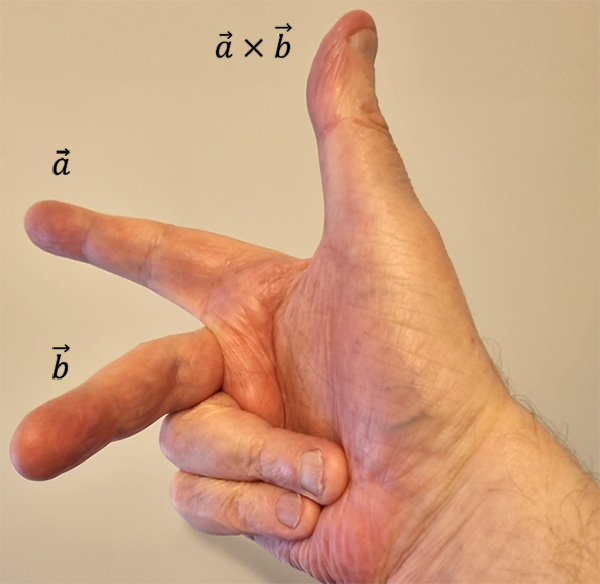Determinant of a matrix
To find the magnitude of a vector, you need to convert the vectors into matrices and find the determinant. Go back and review this concept if you need to.
The vector product is another way to multiply two vectors. Just like scalar products, vector products have many broad applications, such as in electrical engineering, quantum physics, software development, game programming and statistics. Use this resource to learn more.
The vector product is a vector resulting from multiplying the magnitudes (size) of two vectors. Compare this to the scalar or dot product, which gives a scalar.
The magnitudes are found using matrices and determinants, so make sure you are confident with these before you continue.
Let's consider the unit vectors \(\hat{i}\), \(\hat{j}\) and \(\hat{k}\) which are in the \(x\), \(y\) and \(z\) directions, respectively. We can write these as:
\[\begin{align*} \hat{i} & = \hat{i}+0\hat{j}+0\hat{k}\\
& = (1,0,0)
\end{align*}\] \[\begin{align*} \hat{j} & = 0\hat{i}+\hat{j}+0\hat{k}\\
& = (0,1,0)
\end{align*}\] \[\begin{align*} \hat{k} & = 0\hat{i}+0\hat{j}+\hat{k}\\
& = (0,0,1)
\end{align*}\] They give us two vectors:
\[\vec{a} = a_{1}\hat{i}+a_{2}\hat{j}+a_{3}\hat{k}\] \[\vec{b} = b_{1}\hat{i}+b_{2}\hat{j}+b_{3}\hat{k}\] Geometrically, the vector product is found using: \[\vec{a}\times\vec{b}=\left|\vec{a}\right|\left|\vec{b}\right|\sin(\theta)\hat{n}\] where \(\hat{n}\) is a unit vector perpendicular to both \(\vec{a}\) and \(\vec{b}\) and \(\theta\) is the angle between the vectors.

This helps us understand the magnitude and direction of the vector, but in practice, we use the component form:
\[\begin{align*} \vec{a}\times\vec{b} & = \left| \begin{array}{ccc} \hat{i} & \hat{j} & \hat{k}\\
a_{1} & a_{2} & a_{3}\\
b_{1} & b_{2} & b_{3}
\end{array} \right| \\
& = \hat{i}\left| \begin{array}{cc} a_{2} & a_{3}\\
b_{3} & b_{3}
\end{array} \right| - \hat{j}\left| \begin{array}{cc} a_{1} & a_{3}\\
b_{1} & b_{3}
\end{array} \right| + \hat{k}\left| \begin{array}{cc} a_{1} & a_{2}\\
b_{1} & b_{2}
\end{array} \right| \\
& = \hat{i}(a_{2}b_{3}-b_{2}a_{3})-\hat{j}(a_{1}b_{3}-b_{1}a_{3})+\hat{k}(a_{1}b_{2}-b_{1}a_{2})
\end{align*}\]
The vector product is also commonly referred to as the cross product as a cross (or multiplication symbol) is used between the two vectors being multiplied.
Keep in mind that the vertical delimiters (\(\left| \right|)\) here denote the determinant of the matrix, and not the magnitude of the vector.
There are some key characteristics of vector products that are handy to remember.

Find \(\vec{a}\times\vec{b}\) if \(\vec{a}=2\vec{i}+3\vec{j}+\vec{k}\) and \(\vec{b}=5\vec{j}+3\vec{k}\).
Vectors must first be written in matrix form. We place the variables—in this case, the unit vectors—in the first row. In the second and third rows of the matrix, we put the corresponding coefficients for the vectors \(\vec{a}\) and \(\vec{b}\), respectively.
This gives us the matrix:
\[\begin{align*} \vec{a}\times\vec{b} & = \left| \begin{array}{ccc} \hat{i} & \hat{j} & \hat{k}\\
2 & 3 & 1\\
0 & 5 & 3
\end{array} \right|
\end{align*}\]
To find the vector or cross product, we simply find the determinant of the matrix.
We can arrive at this result more quickly if we notice that \(\vec{b}=4\vec{a}\). This indicates that \(\vec{a}\) and \(\vec{b}\) are parallel. Based on the first property of vector products outlined previously, \(\vec{a}\times\vec{b}=\vec{0}\) if \(\vec{a}\) and \(\vec{b}\) are parallel.
If we just look at the cartesian unit vectors—that is, the unit vectors that lie along the \(x\)-, \(y\)- and \(z\)-axes—there are a few rules that are helpful to remember.
Again, we will let \(\hat{i}\), \(\hat{j}\) and \(\hat{k}\) be unit vectors in the \(x\), \(y\) and \(z\) directions, respectively. The rules are:
These rules make finding the vector product more efficient as we can derive answers without having to complete calculations.
Find \(\hat{i}\times\hat{k}\).
We can write these are vectors first.
\[\hat{i}=\hat{i}+0\hat{j}+0\hat{k}\] \[\hat{k}=0\hat{i}+0\hat{j}+\hat{k}\]
Now, let's find the vector product.
Images on this page by RMIT, licensed under CC BY-NC 4.0